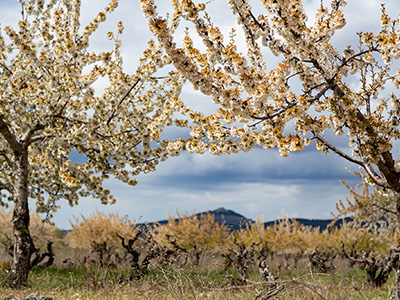Viñedos Olvidados
Finca La Revilla, s/n. 47316 Piñel de Arriba (Valladolid)
valtravieso.com/vinedos-denominaciones-origen/
Viñedos Olvidados is a new venture by Ribera del Duero producer Valtravieso. The aim is to explore the potential of wine regions which are somewhat off the beaten track but boast a notable heritage of traditional vineyards. The project began in three very different locations: Arlanza, Ribera del Júcar and Jumilla.
Arlanza
In Arlanza, the focus is on Covarrubias, the highest village in the DO, where vineyards are planted at 1,000 metres above sea level. With its own microclimate, this valley has cherry trees planted among the vines. It is a rather extreme area with a high risk of frost and vines exposed to wildlife. Valtravieso has joined forces with Luis Martín, a wine distributor based in Valladolid who has been producing wine in the area, first as part of Sabinares and later on his own. Tempranillo is the dominant grape variety, but others like Mencía, Garnacha, Mazuelo, Albillo, Viura or Alarije are also grown.
The range of wine include the unctuous white Muniadona (just over 300 bottles, €92), a blend of around 65% Albillo plus a host of other varieties (Viura, Alarije, Hebén, Castellana Blanca, Cayetana Blanca) and two reds. The fragrant field blend Las Mamblas (around 3,000 bottles, €36) is the village wine, whereas grapes for the deeper, yet extremely subtle Cerro Cerezo (€77) are sourced from Los Lirios, a site on the left bank of the Arlanza river with sandy-pebbly soils over silty clay.
Ribera del Júcar and Jumilla
In Ribera del Júcar (Cuenca), they seek to highlight the unique character of its clay-limestone soils, which are totally covered by pebbles. In fact, the name Milcantos Bobal (€34), the only wine produced here so far, refers to this very fact. Is is a powerful red made with a small amount of old vine Airén grapes.
In Jumilla, they use ungrafted vines (pie franco) grown on limestone soils and surrounded by wooded areas at almost 1,000 metres elevation in the village of Fuenteálamo (Albacete). Pie Firme Monastrell (€38, 2,000 bottles) is made in a 2,000-litre foudre and 500-litre barrels. Despite the long maceration process, the wine is fragrant, sapid and balsamic.
Valtravieso’s approach is really unusual for a winery based in Ribera del Duero since Rueda and Toro were the region’s traditional expansion areas followed more recently by Bierzo, Rioja or Galicia.
Most popular
NEWSLETTER
Join our community of Spanish wine lovers


